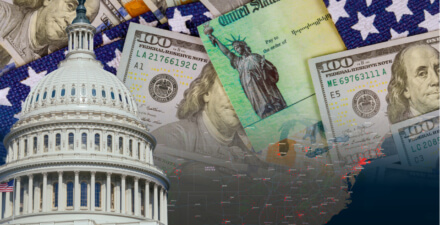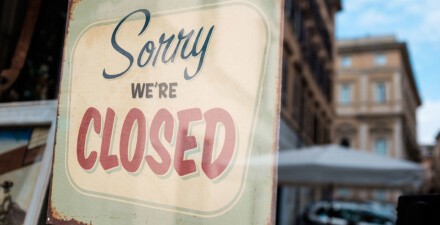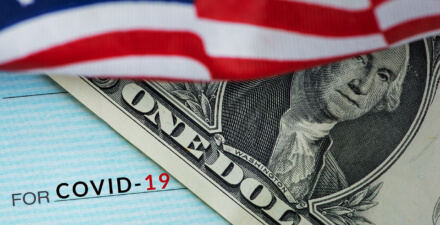Early lessons learned from the U.S. Small Business Administration’s first round of lending from its Paycheck Protection Program

Overview
Underscoring the direness of the coronavirus recession, Congress just reached an agreement to provide another $380 billion in rescue funding for small businesses, just one month after the passage of the $2.2 trillion Coronavirus Aid, Relief, and Economic Security Act. The small business loans authorized in the CARES Act and expanded this week are known as the Small Business Administration’s Paycheck Protection Program. These funds were among the first sources of rescue funding to be vacuumed up by desperate borrowers, whose businesses have been shuttered or severely hamstrung by the pandemic.
Despite hiccups in getting the program running, the $349 billion funding first deployed by the SBA on April 3 evaporated in just two weeks—a significant policy accomplishment but also a testament to the pent-up demand for help. What early lessons can we learn from the rollout of this first round of lending? There are several, but first, policymakers and economists alike need to understand the already existing skeins of economic inequality that, in large part, biased how these funds would be disbursed.
Previous research from the Washington Center for Equitable Growth documents how small business formation has declined over the past four decades in lockstep with an increase in economic inequality and discusses how these two phenomena may be interrelated. Equitable Growth also documented how policymakers in the CARES Act and via Federal Reserve lending facilities reinforced existing advantages for large businesses and how that might exacerbate inequality, including gaps in wealth by race, ethnicity, and gender.
The result: Large businesses, and the most advantaged small businesses, may come out the other side of the coronavirus recession intact—or even stronger than before—while others are forced to either close or significantly downsize.
The long-term implications for business dynamism and inequality in the United States as a result of the coronavirus recession and the resulting policy responses may not be known for years. But there are ways to glean early lessons from the first round of small business funding, specifically by looking at:
- Data on loan sizes and distribution in the Paycheck Protection Program
- Data on sectoral distribution of the Paycheck Protection Program funding
- Anecdotal stories about gaining access to the Paycheck Protection Program
Let’s examine each of these more closely.
Download FileEarly lessons learned from the U.S. Small Business Administration’s first round of lending from its Paycheck Protection Program
Data on loan sizes and distribution in the Paycheck Protection Program
The data we have on the first round of funding show that 1.66 million loans were made under the Paycheck Protection Program, compared to 30 million small businesses nationwide, 6 million of which are firms with employees (versus sole proprietorships). This means Congress reached just one half of 1 percent of eligible businesses, or around 28 percent of all firms with employees.
While the Small Business Administration touted that nearly three-quarters of the loans made under the Paycheck Protection Program were for amounts of less than $150,000, the full picture is a bit more complicated. A breakdown of the data show that just 4 percent of the loans made accounted for nearly 45 percent of the total pot of money made available under the program. Just a few loans at the top accounted for a sizeable share of the funding, with 0.03 percent of the loans made having been for more than $5 million, representing a whopping 9 percent of all funding. This lopsided distribution means that certain larger qualifying small businesses managed to secure an outsized portion of the total funding.
Data on sectoral distribution of the Paycheck Protection Program funding
Data released by the Small Business Administration also paints a curious picture in terms of which sectors benefitted from the loan program. The construction industry, for example, received more than 13 percent of total loan amounts despite representing only 4 percent of nonfarm payroll job losses in March 2020—the first month in which job losses amid the coronavirus pandemic became apparent. Meanwhile, retail and hospitality, mainly food and drinking establishments, represented 65 percent of job losses last month but only received only around 9 percent of available small business loan amounts.
While we do not have clear data on why this is the case, one hypothesis is that individual construction loans may be larger, on average, than individual retail and hospitality loans, given the capital-intensive nature of the construction business. But because these loans are for payroll protection and are capped at $10 million, this likely isn’t the case. Indeed, the construction industry received both an outsized percentage of the total amount loaned out and the total number of individual loans—meaning that the industry dominated both in the rescue aid delivered and the number of firms assisted.
A more compelling hypothesis is that the construction industry is more likely to be deemed “essential” than other business sectors. One construction industry state-by-state tracker showed that the industry is permitted to stay open, with some public health guidelines in place, in all but a few states. In contrast, restaurants in every single state are subject to strict public health restrictions, including a prohibition on dine-in services. This suggests that small firms whose business models remain the least disrupted are the most likely to receive loans—a perverse outcome for a program designed to help the most vulnerable firms.
This deeply unequal distribution of the Paycheck Protection Program funds is perhaps a reflection on some of the punitive and complex aspects of the program itself, including restrictions on use of funds and the requirement to quickly rehire employees. In other words, the businesses that were most confident in their survival, where COVID-19 (the disease caused by the new coronavirus) has imposed the least damage on revenue, were also the most able to access loans.
Other estimates from Bloomberg showed that small business funding as a proportion of eligible payroll fared much better in the middle of the country versus the coasts. While there’s not enough information yet to suggest why this was the case, Bloomberg hypothesized that businesses in regions hit hard by the virus, such as those in and around New York City, Seattle, and San Francisco, may have had less bandwidth to submit loan applications than those elsewhere in the country.
In addition to circumstances that would make it hard to apply for funding, program rules requiring relatively quick rehiring of employees as a condition of loan forgiveness may have been too limiting for businesses in areas with protracted lockdowns, whose chance of repayment is less likely. Finally, businesses in the middle of the country may have had more access to community-based lenders, who may have been able to process applications requiring idiosyncratic underwriting faster than large banks.
All of these trends could end up having a significant impact on the shape of the recovery as, say, construction businesses in North Dakota receive help while a small restaurant in the service-industry-heavy Nevada misses out.
Anecdotal stories about gaining access to the Paycheck Protection Program
Beyond the limited data, journalists have uncovered a number of stories related to which firms both loaned out and borrowed the money. Reporting indicates that small lending institutions did a better job of deploying funding quickly, perhaps because of closer relationships with community businesses, less internal bureaucracy, or a willingness to act more quickly and on less information. Some small businesses are going so far as to sue large banking institutions, alleging that those banks prioritized high-value loans first rather than taking them on a first-come, first-served basis.
Other reporting has documented how seemingly unlikely firms received small business loans. One Bloomberg report, for example, documented how hedge funds—or big pools of money whose purpose is to speculate in financial markets—qualified for the Paycheck Protection Program.
Other stories uncovered how the publicly traded fast-casual chain Shake Shack Inc. received a $10 million loan and then pledged to return it after a public backlash—but not before the company found other sources of funding, including drawing down on a $50 million line of credit from Wells Fargo & Co. and raising $150 million in equity markets.
A Securities and Exchange Act filing by Shake Shack offers a window into how large chain restaurants may fare during and after the coronavirus recession. The company said that the pandemic and ensuing economic downturn may actually be positive for the firm, noting that it “believes additional and improved development opportunities may be available over time due to the impact of COVID-19 on the overall retail and real estate environment.” This could be for a number of reasons, but presumably, the company thinks that the economic environment going forward may allow it to increase its market share over the long term or even benefit from cheaper commercial real estate prices as the economy heads into a prolonged recession.
Journalists have highlighted other instances of publicly traded restaurant groups receiving small business funding. In those cases, the businesses have not undertaken efforts to return the money. This includes Ruth’s Hospitality Group, Inc, the owner of the Ruth’s Chris steakhouse chain, which had $86 million of cash in reserves, paid its chief executive officer $6.1 million last year, and bought back more than 1.1 million shares of its own stock at an aggregate cost of $25.8 million in 2019.
But a large chain restaurant’s positive news is another business’s extinction event. Indeed, the National Restaurant Association predicts that 75 percent of independent restaurants may permanently shutter because of the coronavirus.
While neither policymakers nor economists have enough data yet to reach firm conclusions, these anecdotes suggest that the small business lending program may not be meeting all of policymakers’ original goals. In fact, one New York Post story said that Wall Street executives were actually scared that bailout funds skewed too heavily toward the top, and that imbalance may inspire a political backlash.
Conclusion
Luckily, the disproportionate harm caused to small businesses by the coronavirus recession is not inevitable. Policymakers have wide latitude to shape how our economy looks coming out of the economic downturn and into the recovery. This second round of funding by the Small Business Administration through the Paycheck Protection Program is an important next step, and hopefully businesses in the hardest-hit sectors, in previously neglected states, and among those smallest of small businesses seeking small-value loans will be assisted.
Banking industry insiders are predicting that the next round of small business funding could evaporate in just two days. Congress should consider massively scaling these investments, ideally making the funds guaranteed for all eligible small businesses. If this program is to reach all those that need it, it seems that at least $1 trillion in funding is required. As reports come in about certain sophisticated firms benefitting from the first round of small business funding, it would represent a big missed opportunity if Congress stopped its work after the $380 billion is allocated beginning this week.
Beyond the too-small funding amount, the biggest disappointment of the small business loan program so far is the lack of data collection on applications received and loans funded. Without a view into this, policymakers, law enforcement, advocates, and researchers will find it hard to determine patterns of who did and who did not receive rescue money.
Finally, even as Congress works remotely, oversight will be essential. Legislators, the Inspector General for the CARES Act, and the special congressional panel assembled to oversee bailout funds should conduct rigorous oversight of the Paycheck Protection Program. In the case of the special congressional oversight panel authorized under Title IV of the CARES Act, Congress may need to expand the statute to provide more oversight authority, as currently the panel can only evaluate how the Federal Reserve will purchase packages of these loans from lenders. Key questions should be raised, among them whether and how lenders prioritized potential borrowers, and whether the lenders privileged applications from small businesses that owe the lender other debts.
Many challenges remain to ensuring the survival of U.S. small businesses. Congress must be diligent and see this aid through. The survival of many small firms depends on it.






